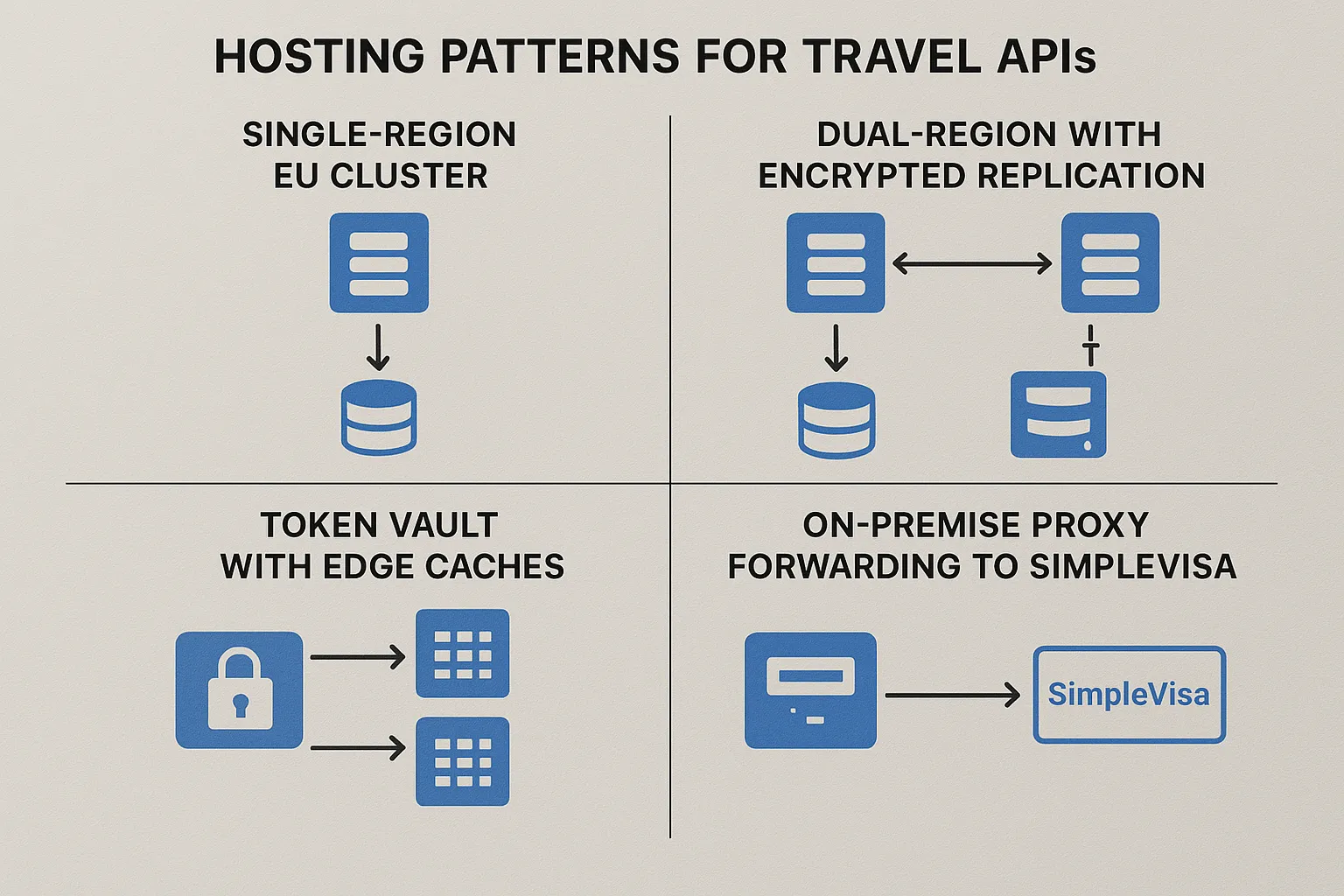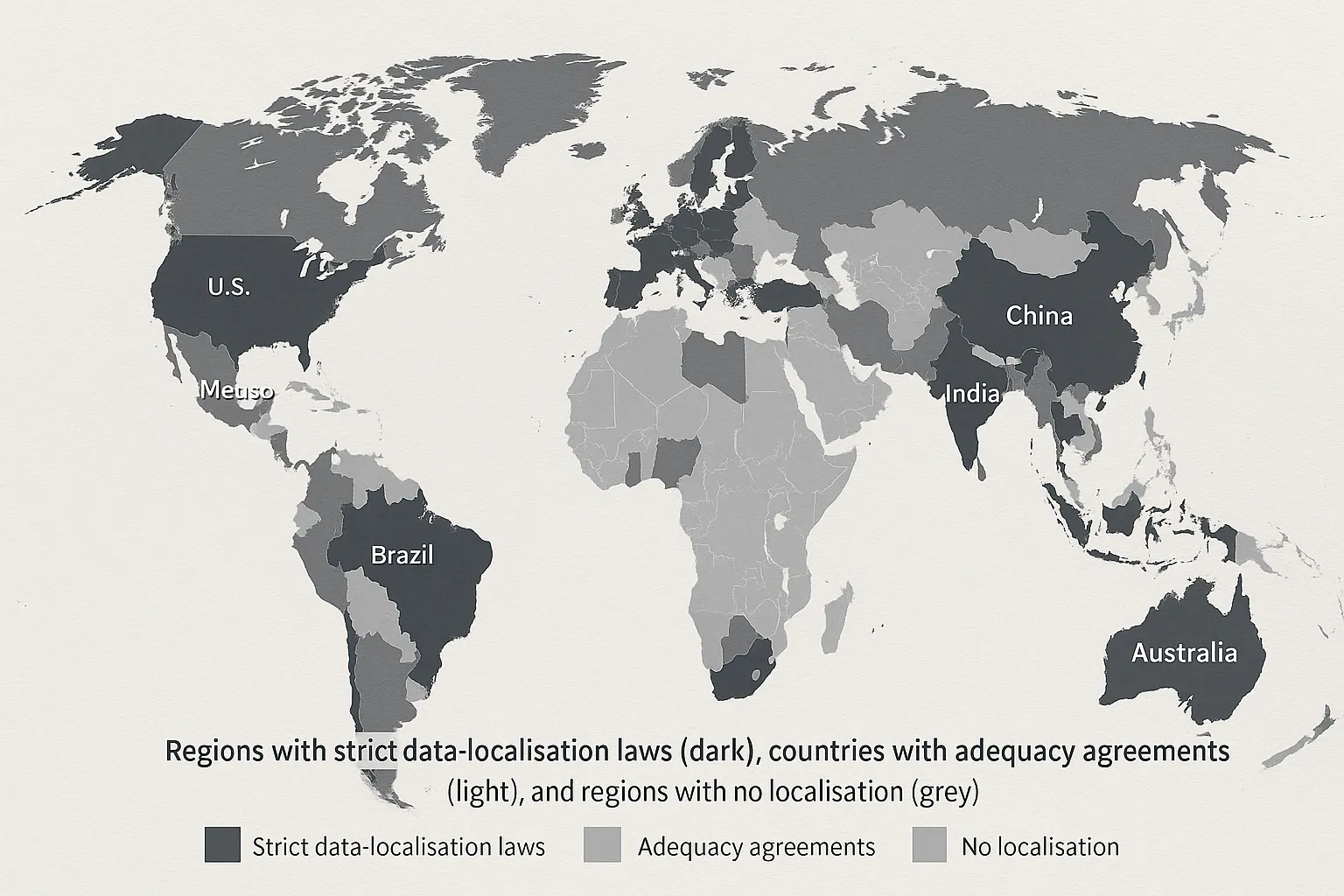Data Residency 101 for Travel APIs: Where Your Visa Data Can Legally Live

Visa data may travel the world long before the passenger does – moving from your booking engine to a document-verification service, through payment processors and finally to border-control systems. Each hop adds legal obligations about where that information is stored and who can access it. Get data-residency wrong and you risk multi-million-dollar fines, denied boardings, and terminated partnerships. Get it right and you unlock faster go-lives, higher approval rates, and peace of mind for regulators and customers alike.
1. Data Residency, Sovereignty, Localisation: Know the Jargon
- Data residency: the physical or geographic location where data is stored at rest. Many SaaS platforms offer a choice of regions (for example,
eu-centralorus-east). - Data sovereignty: the principle that data is subject to the laws of the country where it resides. An EU-hosted database must comply with GDPR even if the company is headquartered elsewhere.
- Data localisation: a legal requirement that certain datasets never leave national borders (full localisation) or that a primary copy must stay onshore (partial localisation). China’s PIPL and Russia’s Federal Law 242-FZ are well-known examples.
Understanding which bucket your visa data falls into drives every architecture and vendor decision that follows.
2. Why Visa Data Is Treated as High-Risk
Visa workflows handle more than names and emails. Typical payloads include:
| Data element | Category under GDPR | Additional considerations |
|---|---|---|
| Passport number, birth date | Personally Identifiable Information (PII) | Direct identifier; strict breach-notification rules |
| Biometric photo | Special category data (Art. 9) | Requires explicit consent; heightened security |
| Travel itinerary | Behavioural data | May reveal political or religious inference when combined with destination |
| Payment details | PCI DSS scope | Separate tokenisation requirements |
Because these fields can be combined to commit identity theft or track an individual’s movements, most regulators classify them as sensitive or special category data. That means extra encryption, audit logging, and—crucially—controls on cross-border transfers.
3. The Global Data-Residency Landscape for Travel APIs
| Region / Country | Flagship law | Cross-border transfer test | Max fine (headline) |
|---|---|---|---|
| European Economic Area | GDPR Arts. 44-49 | Adequacy decision, SCCs or BCRs | 4 % of worldwide revenue |
| United Kingdom | UK GDPR & DPA 2018 | Similar to EU SCCs; UK IDTA | GBP 17.5 m or 4 % turnover |
| United States | CLOUD Act, CCPA, state laws | No federal localisation; contract and encryption best practice | Up to USD 7,500 per record (CCPA) |
| China | Personal Information Protection Law (PIPL) | Mandatory security assessment for transfers; critical info must stay onshore | 5 % of annual revenue or CNY 50 m |
| Russia | Federal Law 242-FZ | Primary copy must be stored on Russian servers | Blocking orders + fines |
| Singapore | PDPA 2020 | Comparable protection required; contract + assessments | SGD 1 m or 10 % revenue |
Sources: European Data Protection Board, UK ICO, U.S. FTC, NPC China, Roskomnadzor, Singapore PDPC (accessed September 2025).
4. Legal Mechanisms to Move Visa Data Across Borders
- Standard Contractual Clauses (SCCs) – Pre-approved clauses binding exporter and importer. Updated 2021 version addresses Schrems II requirements.
- Binding Corporate Rules (BCRs) – Internal policy for multinational groups; lengthy but future-proof.
- Adequacy Decisions – Countries deemed by the EU to provide “essentially equivalent” protection (e.g. Japan, South Korea, the new EU-US Data Privacy Framework).
- Sector-specific gateways – IATA passenger-data exchange, U.S. CBP APIS filings, or direct government-to-government feeds.
- Encryption and tokenisation – While not a legal basis alone, strong encryption with keys held in-region can lower transfer risk and influence regulator assessments.
5. Architecture Patterns for Compliant Travel APIs

- Single-Region Hosting – Simplest to reason about; often chosen by EU-only OTAs. Downside: higher latency for APAC travellers and disaster-recovery limitations.
- Multi-Region Mirrored Clusters – Data is replicated in encrypted form between regions. You need a lawful transfer mechanism and granular access controls.
- Regional Token Vaults – Passport numbers and biometrics stay in the origin region; other micro-services store only opaque tokens. Popular after Schrems II.
- Edge Processing, Central Encrypted Store – Raw PII processed at edge; irreversible hashes or decision outcomes flow to a global store.
Selecting a pattern depends on your markets, latency targets, and risk appetite—but mapping every API endpoint to a data-classification matrix should always be step one.
6. Residency Checklist Before You Hit “Deploy”
- Map data flows from booking widget to visa-status webhook.
- Classify each field: standard PII vs special category vs payment.
- Identify all sub-processors (cloud DB, log service, email provider).
- Choose a residency pattern and document why it meets legal tests.
- Execute SCCs or local equivalents with every partner that touches the data.
- Implement customer-visible controls (download, delete, rectify) inside SLA.
- Run disaster-recovery drills that respect residency (e.g. EU backup succeeds without copying to US).
- Monitor regulatory updates—China’s CAC rules, EU adequacy lists, U.S. state privacy laws—and revisit the map quarterly.
Quick-Reference Table: Visa Data Elements vs Retention & Residency
| Data field | Recommended retention | Residency best practice | Deletion trigger |
|---|---|---|---|
| Passport photo | 6 months post-travel | Same region as traveller booking | Auto-purge + audit log |
| Visa PDF | Duration of visa validity | Region of destination country or adequacy-approved region | Visa expiry + 30 days |
| Payment token | Per PCI DSS rules | Token vault in same region as payment processor | Chargeback window end |
| Webhook logs | 90 days | Pseudonymised logs in compliance region | Rolling daily purge |
7. Mini-Case Study: An OTA Preparing for ETIAS
A mid-size European online travel agency faced two pressures:
- ETIAS (due 2025) requires sensitive pre-screening data on EU soil.
- 35 % of its customer base is U.S.-origin, meaning data often starts in the U.S.
Solution: The OTA adopted a token-vault pattern. Raw passport data is collected in a U.S. front-end but immediately encrypted and sent to an EU vault managed by its visa provider. Only a short-lived token travels back to the booking flow. The approach passed an external GDPR audit and shaved 600 ms off API roundtrips compared with routing everything through a single EU server.
8. Where SimpleVisa Fits In
SimpleVisa was designed for privacy by default. Key points for compliance teams:
- Region-aware infrastructure. SimpleVisa’s API offers EU and U.S. hosting options and will not move data outside the selected region without explicit customer instruction.
- Granular scopes. Partner applications request only the endpoints they need, limiting over-collection.
- Transparent sub-processor list. Updated quarterly in the Partner Portal so you can complete transfer-impact assessments faster.
- Developer tooling. Webhooks include region tags, and JWT claims let you enforce region-based access in your own services. See the Developer Q&A on API authentication for implementation details.
- Independent security audits. SimpleVisa undergoes annual penetration testing and publishes executive summaries for customer review (latest: July 2025).
For a deeper dive into our encryption model and physical-security controls, read How Secure is the Electronic Visa System? inside our Security Hub: https://simplevisa.com/how-secure-is-the-e-visa-system/.

9. Key Takeaways
- Visa data is special-category PII; regulators watch it closely.
- Residency is not just about storage—it includes logs, backups and failovers.
- Map your data flows, choose a residency pattern, and lock down contractual safeguards before launch.
- Monitor evolving localisation laws in China, India, GCC, and the EU–US corridor.
- Selecting a visa API provider with region-flexible hosting and transparent sub-processor lists removes 80 % of the integration burden.
Ready to audit your current visa-data footprint or plan a new integration? Book a 20-minute call with our compliance engineers and discover how SimpleVisa can align with your data-residency strategy while unlocking new ancillary revenue streams.